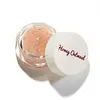What's inside
What's inside
 Key Ingredients
Key Ingredients

 Benefits
Benefits

 Concerns
Concerns

 Ingredients Side-by-side
Ingredients Side-by-side

Polyglyceryl-2 Triisostearate
EmulsifyingPhytosteryl Isostearyl Dimer Dilinoleate
EmollientDiisostearyl Malate
EmollientPolyisobutene
Synthetic Wax
AbrasiveHelianthus Annuus Seed Oil
EmollientOlea Europaea Fruit Oil
MaskingMicrocrystalline Wax
Emulsion StabilisingSynthetic Beeswax
Emulsion StabilisingEthylene/Propylene Copolymer
Abrasive1,2-Hexanediol
Skin ConditioningCalcium Carbonate
AbrasiveTitanium Dioxide
Cosmetic ColorantCalcium Titanium Borosilicate
AbrasiveParfum
MaskingCaprylyl Glycol
EmollientEthylhexylglycerin
Skin ConditioningPentaerythrityl Tetra-Di-T-Butyl Hydroxyhydrocinnamate
AntioxidantCI 77891
Cosmetic ColorantCI 15985
Cosmetic ColorantCI 73360
Cosmetic ColorantTocopherol
AntioxidantTin Oxide
AbrasiveWater
Skin ConditioningDiamond Powder
AbrasiveRuby Powder
Skin ConditioningSapphire Powder
Polyglyceryl-2 Triisostearate, Phytosteryl Isostearyl Dimer Dilinoleate, Diisostearyl Malate, Polyisobutene, Synthetic Wax, Helianthus Annuus Seed Oil, Olea Europaea Fruit Oil, Microcrystalline Wax, Synthetic Beeswax, Ethylene/Propylene Copolymer, 1,2-Hexanediol, Calcium Carbonate, Titanium Dioxide, Calcium Titanium Borosilicate, Parfum, Caprylyl Glycol, Ethylhexylglycerin, Pentaerythrityl Tetra-Di-T-Butyl Hydroxyhydrocinnamate, CI 77891, CI 15985, CI 73360, Tocopherol, Tin Oxide, Water, Diamond Powder, Ruby Powder, Sapphire Powder
Petrolatum
EmollientSucrose
HumectantMicrocrystalline Wax
Emulsion StabilisingPhytosteryl/Isostearyl/Cetyl/Stearyl/Behenyl Dimer Dilinoleate
Skin ConditioningDiisostearyl Malate
EmollientPEG-20 Glyceryl Triisostearate
EmollientSilica Silylate
EmollientPrunus Armeniaca Seed Powder
AbrasiveJuglans Regia Shell Powder
Abrasive1,2-Hexanediol
Skin ConditioningCaprylic/Capric Glycerides
EmollientTocopheryl Acetate
AntioxidantParfum
MaskingWater
Skin ConditioningButylene Glycol
HumectantAvena Sativa Meal Extract
SoothingHoney
HumectantSodium Hyaluronate
HumectantHydrolyzed Hyaluronic Acid
HumectantHydroxypropyltrimonium Hyaluronate
Petrolatum, Sucrose, Microcrystalline Wax, Phytosteryl/Isostearyl/Cetyl/Stearyl/Behenyl Dimer Dilinoleate, Diisostearyl Malate, PEG-20 Glyceryl Triisostearate, Silica Silylate, Prunus Armeniaca Seed Powder, Juglans Regia Shell Powder, 1,2-Hexanediol, Caprylic/Capric Glycerides, Tocopheryl Acetate, Parfum, Water, Butylene Glycol, Avena Sativa Meal Extract, Honey, Sodium Hyaluronate, Hydrolyzed Hyaluronic Acid, Hydroxypropyltrimonium Hyaluronate
 Reviews
Reviews

Ingredients Explained
These ingredients are found in both products.
Ingredients higher up in an ingredient list are typically present in a larger amount.
1,2-Hexanediol is a synthetic liquid and another multi-functional powerhouse.
It is a:
- Humectant, drawing moisture into the skin
- Emollient, helping to soften skin
- Solvent, dispersing and stabilizing formulas
- Preservative booster, enhancing the antimicrobial activity of other preservatives
Diisostearyl Malate is an emollient and most often used in lip products. It comes from isostearyl alcohol, a fatty acid, and malic acid, an AHA.
As an emollient, Diisostearyl Malate helps create a thin film on your skin to trap moisture in. This helps keep your skin soft and smooth.
Microcrystalline Wax is created by de-oiling petroleum. It is highly refined and purified before being added to cosmetics.
Microcrystalline Wax is used to enhance the texture and create even consistency. It helps stabilize a product by preventing ingredients from separating.
Parfum is a catch-all term for an ingredient or more that is used to give a scent to products.
Also called "fragrance", this ingredient can be a blend of hundreds of chemicals or plant oils. This means every product with "fragrance" or "parfum" in the ingredients list is a different mixture.
For instance, Habanolide is a proprietary trade name for a specific aroma chemical. When used as a fragrance ingredient in cosmetics, most aroma chemicals fall under the broad labeling category of “FRAGRANCE” or “PARFUM” according to EU and US regulations.
The term 'parfum' or 'fragrance' is not regulated in many countries. In many cases, it is up to the brand to define this term.
For instance, many brands choose to label themselves as "fragrance-free" because they are not using synthetic fragrances. However, their products may still contain ingredients such as essential oils that are considered a fragrance by INCI standards.
One example is Calendula flower extract. Calendula is an essential oil that still imparts a scent or 'fragrance'.
Depending on the blend, the ingredients in the mixture can cause allergies and sensitivities on the skin. Some ingredients that are known EU allergens include linalool and citronellol.
Parfum can also be used to mask or cover an unpleasant scent.
The bottom line is: not all fragrances/parfum/ingredients are created equally. If you are worried about fragrances, we recommend taking a closer look at an ingredient. And of course, we always recommend speaking with a professional.
Learn more about ParfumWater. It's the most common cosmetic ingredient of all. You'll usually see it at the top of ingredient lists, meaning that it makes up the largest part of the product.
So why is it so popular? Water most often acts as a solvent - this means that it helps dissolve other ingredients into the formulation.
You'll also recognize water as that liquid we all need to stay alive. If you see this, drink a glass of water. Stay hydrated!
Learn more about Water